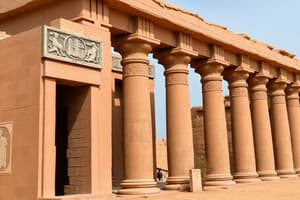Podcast
Questions and Answers
Alin sa mga sumusunod na lugar ang kilalang sibilisasyon sa pagitan ng mga ilog Tigris at Euphrates?
Alin sa mga sumusunod na lugar ang kilalang sibilisasyon sa pagitan ng mga ilog Tigris at Euphrates?
- Egypt
- Indus Valley
- Mesopotamia (correct)
- China
Ang mga sibilisasyon sa Indus Valley ay may mahusay na sistema ng paagusan.
Ang mga sibilisasyon sa Indus Valley ay may mahusay na sistema ng paagusan.
True (A)
Ano ang pangunahing anyo ng komunikasyon sa sinaunang Ehipto?
Ano ang pangunahing anyo ng komunikasyon sa sinaunang Ehipto?
Hieroglyphic writing
Ang mga ____ ay mahalagang bahagi ng lipunan sa Mesopotamia.
Ang mga ____ ay mahalagang bahagi ng lipunan sa Mesopotamia.
Anong salik ang nagpasimula sa pag-usbong ng mga sinaunang sibilisasyon?
Anong salik ang nagpasimula sa pag-usbong ng mga sinaunang sibilisasyon?
Anong mga pilosopiya ang may malaking impluwensya sa kulturang Tsino?
Anong mga pilosopiya ang may malaking impluwensya sa kulturang Tsino?
Ang mga sibilisasyon sa Americas ay nakabuo ng sopistikadong lipunan nang hindi naapektuhan ng ibang sibilisasyon.
Ang mga sibilisasyon sa Americas ay nakabuo ng sopistikadong lipunan nang hindi naapektuhan ng ibang sibilisasyon.
Ang mga ____ sa sinaunang Egypt ay nagpapakita ng mga kakayahan sa inhinyeriya.
Ang mga ____ sa sinaunang Egypt ay nagpapakita ng mga kakayahan sa inhinyeriya.
Flashcards
Early Civilizations
Early Civilizations
Societies that developed independently in various parts of the world, often in fertile river valleys, forming the basis for modern societies.
Mesopotamia
Mesopotamia
An ancient civilization located between the Tigris and Euphrates rivers, known for its city-states and innovations like cuneiform writing.
Egyptian Civilization
Egyptian Civilization
A stable, unified civilization along the Nile River, noted for pyramids, hieroglyphics, and a strong belief in the afterlife.
Indus Valley Civilization
Indus Valley Civilization
Signup and view all the flashcards
Agricultural Surplus
Agricultural Surplus
Signup and view all the flashcards
Social Hierarchy
Social Hierarchy
Signup and view all the flashcards
Cuneiform Writing
Cuneiform Writing
Signup and view all the flashcards
Hieroglyphic Writing
Hieroglyphic Writing
Signup and view all the flashcards
Urban Planning
Urban Planning
Signup and view all the flashcards
Organized Governments
Organized Governments
Signup and view all the flashcards
Study Notes
Early Civilizations
- Early civilizations emerged in various parts of the world independently, driven by environmental factors like fertile river valleys facilitating agriculture.
- Mesopotamia, located between the Tigris and Euphrates rivers, is considered one of the earliest known civilizations. Its development was marked by advancements in irrigation, agriculture, and urban planning.
- Egypt, located along the Nile River, developed a complex civilization marked by monumental architecture, like the pyramids, and sophisticated systems of writing.
- Indus Valley Civilization thrived in the Indus River valley, demonstrating impressive urban planning and sophisticated drainage systems.
- The emergence of these civilizations was gradual, influenced by evolving social structures.
- These civilizations laid the foundation for many aspects of modern society, profoundly influencing cultural and scientific advancements.
Characteristics of Ancient Civilizations
- Agriculture: Agricultural surplus allowed for specialization of labor and the development of cities.
- Social Hierarchy: Civilizations typically exhibited a hierarchical social structure, with elites, priests, artisans, and peasants.
- Political Organization: Organized governments with rules and laws emerged, often headed by kings or pharaohs.
- Religion and Mythology: Belief systems and elaborate mythologies played crucial roles in shaping daily life and explaining natural phenomena.
Mesopotamia
- Mesopotamia's city-states were often independent, constantly vying for dominance.
- The development of cuneiform writing enabled record-keeping and communication.
- Significant contributions included advancements in mathematics, astronomy, and law codes (e.g., Code of Hammurabi).
- Mesopotamian society was polytheistic, with numerous gods and goddesses associated with natural forces.
Egypt
- Egyptian civilization was characterized by its stability and unified rule, under pharaohs.
- Hieroglyphic writing served as the primary form of communication.
- Concepts of afterlife and mummification were central to Egyptian culture.
- Monumental architecture, including pyramids and temples, showcased the advanced engineering capabilities.
- Strong centralized government and religious authority were intertwined.
Indus Valley Civilization
- Evidence suggests advanced urban planning and sanitation systems.
- A sophisticated drainage system indicative of organized city life.
- The script of the Indus Valley remains largely undeciphered.
- Trade networks possibly connected the Indus Valley with other early civilizations.
- The decline of the civilization remains a topic of scholarly debate.
Ancient China
- The Yellow River valley was crucial for the development of early Chinese civilization.
- Early Chinese dynasties, such as the Xia and Shang, emerged.
- The development of Chinese writing systems contributed to cultural continuity.
- Philosophies like Confucianism and Daoism played a transformative role in shaping Chinese culture.
- Innovations in agriculture and technology further propelled civilization's advancements.
Other Regions
- Other early civilizations, such as those in the Americas (e.g., Olmec, Chavin), independently developed sophisticated societies.
- These civilizations exhibited unique features shaped by their specific environments and circumstances.
- The study of ancient civilizations provides valuable insights into the development of human societies.
Studying That Suits You
Use AI to generate personalized quizzes and flashcards to suit your learning preferences.




